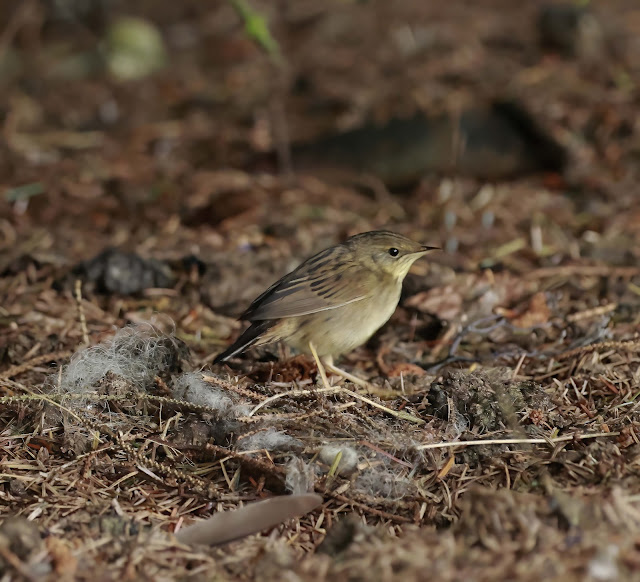Our last day on Shetland arrived, having had three weeks of full on birding.In a way I was glad as both Mark and myself were feeling the pace. You could say we had birded ourselves to a standstill but not quite, for today we went in search of a Turtle Dove in a garden at Sandwick, images of which had been posted on Facebook the night before.
This was not my first Turtle Dove on Shetland as I had gone to see another on the 27th of September at the rather wonderfully named village of Toogs, not that far from Scalloway.Mark had stayed at home but I joined a few other birders to shelter by a wall and watch the dove flying to feed in a garden of one of the houses.It was wary and you could not approach it closely but we all saw it well enough.
Today was a miserable day of low cloud, rain showers and strong wind but we made the pilgrimage to Sandwick and found the house and garden which lay right by the road, just down from the SPAR shop which we had visited a number of times when opportunity allowed, me to purchase the occasional four pack of Tunnocks Caramel Bars and Mark his favourite chocolate coated Brazils.
A large and rather dense conifer tree was at the bottom of the garden and as we stood hunched against the wind it became apparent that, in its densest midst, it was sheltering a couple of Collared Doves, which had revealed themselves as they shifted their perch.Closer scrutiny revealed others in there too, parts of their bodies visible through the thick green of the conifer.This engendered some hope. Could the Turtle Dove be amongst them?
Mark grew impatient and went to the SPAR shop for you know what.I hung on by the wall chatting to some of my fellow birders.
Five minutes elapsed when, for no reason I could fathom, the Collared Doves, many more than suspected, erupted from the conifer in alarm and flew at speed over and away from the garden.I thought I saw a smaller dove with them but could not be sure.
Another five minutes elapsed and the Turtle Dove was found on the top of a large drystone wall on the other side of the garden.How it got there unseen, no one quite knew but such questions were for another time as everyone looked at the dove, remarkably well camouflaged on top of the haphazard stones that comprised the wall and quite content to remain in its exposed position. It stayed there for a long time,its head sunk into its shoulders and looking rather miserable, as so it should. for it really needed to be on its way to warmer southern climes by now.
I called Mark on my mobile to tell him the dove was now visible and he left the shop and walked back to join me.The dove meanwhile stirred itself and then dropped off the wall down into the garden picking at bits and pieces in the grass and coming closer and closer until it hopped from the grass onto a small retaining wall that bordered a concrete path running down the centre of the lawn.
I could see the dove was a juvenile, as one or two brighter coloured second generation adult feathers were coming through on its lesser and median wing coverts.How it got here and why is anyone's guess but it was perfectly healthy and I could only hope it decides to resume its migration south as it certainly has a long way to go to get back on course
I have not seen a Turtle Dove in Britain for over three years and the irony of seeing a second Turtle Dove on Shetland in the space of two weeks was not lost on me.We used to have them breeding on my local RSPB Otmoor reserve in Oxfordshire but they disappeared three years ago.I never thought for one moment I would see my next one, let alone two, on Shetland. Well who would?
THE END
Birds seen on our Shetland Trip
Red throated Diver; Black throated Diver; Great Northern Diver; Slavonian Grebe; Northern Fulmar; Northern Gannet; Cormorant; European Shag; Cattle Egret; Grey Heron; Mute Swan; Whooper Swan; Pink footed Goose; Greylag Goose; Eurasian Wigeon; Eurasian Teal; Mallard; Northern Shoveler; Common Pochard; Tufted Duck; Common Eider, Long tailed Duck; White winged Scoter; Common Goldeneye; Red breasted Merganser; Goosander; Eurasian Sparrowhawk; Common Kestrel; Merlin; Peregrine; Red Grouse; Common Pheasant; Water Rail; Corn Crake x 2; Eurasian Oystercatcher; Ringed Plover; European Golden Plover; Northern Lapwing; Knot; Sanderling; Purple Sandpiper; Common Snipe; Bar-tailed Godwit; Eurasian Curlew; Common Redshank; Turnstone; Arctic Skua; Great Skua; Black headed Gull; Common Gull; Lesser Black-backed Gull; Herring Gull; Great Black-backed Gull; Kittiwake; Sandwich Tern; Guillemot; Razorbill; Black Guillemot; Rock Dove; Wood Pigeon; Collared Dove; Turtle Dove x 2; European Nightjar; Skylark; Barn Swallow; Olive backed Pipit; Pechora Pipit; Meadow Pipit; Rock Pipit; Grey Wagtail; White/Pied Wagtail; Wren; Robin; Bluethroat; Whinchat; Northern Wheatear; Ring Ouzel; Blackbird; Redwing; Pallas's Grasshopper Warbler x 2; Lanceolated Warbler x 2; Paddyfield Warbler; Barred Warbler x 9 ; Lesser Whitethroat; Garden Warbler; Blackcap; Greenish Warbler; Arctic Warbler; Eastern Crowned Warbler (First for Shetland and Scotland); Pallas's Leaf Warbler x 2; Yellow browed Warbler x 23 ;Wood Warbler; Common Chiffchaff; Siberian Chiffchaff; Willow Warbler; Goldcrest; Spotted Flycatcher; Red-breasted Flycatcher; Pied Flycatcher; Golden Oriole; Red-backed Shrike; 'Steppe' Grey Shrike; Jackdaw; Rook; Hooded Crow; Common Raven; Common Starling; Rosy Starling; House Sparrow; Chaffinch; Siskin; Linnet; Twite; Lesser Redpoll; Common Redpoll; Common Rosefinch; Lapland Bunting: Snow Bunting; Little Bunting.
Mammals


.jpg)
.jpg)





.jpg)





.jpg)

.jpg)
.jpg)
.jpg)








.JPG)
.jpg)
.jpg)




.JPG)
.JPG)
.JPG)
.JPG)

.jpg)
.jpg)
.jpg)
.jpg)
.jpg)
.jpg)
.jpg)









